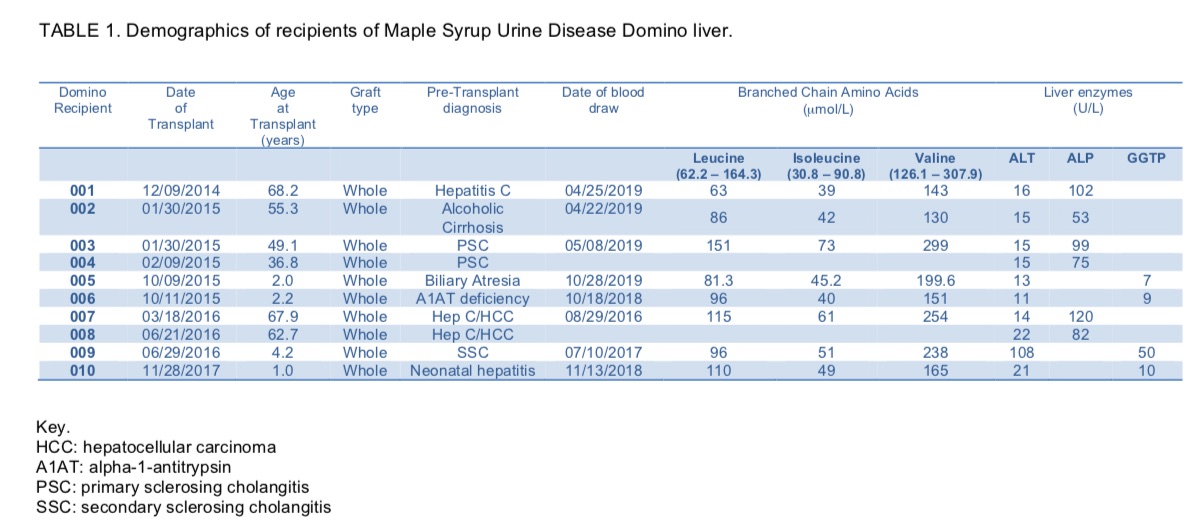Domino Transplantation – Expanding the Liver Donor Pool to the Pediatric Recipient
U. Ekong1, N. Yazigi1, K. Khan1, S. Kaufman1, K. Chapman2, E. Leon2, N. Ah Mew2, A. Kroemer1, R. Girlanda1, J. Hawksworth1, C. Matsumoto1, T. Fishbein1
1MedStar Georgetown Transplant Institute, Washington, DC, 2Genetics, Children's National Hospital, Washington, DC
Meeting: 2020 American Transplant Congress
Abstract number: 588
Keywords: Allocation, Liver transplantation, Metabolic disease, Pediatric
Session Information
Session Time: 3:15pm-4:45pm
 Presentation Time: 4:27pm-4:39pm
Presentation Time: 4:27pm-4:39pm
Location: Virtual
*Purpose: Background: Maple syrup urine disease (MSUD) is an inherited autosomal recessive metabolic disorder of amino acid metabolism, caused by a defect of the branched-chain α-ketoacid dehydrogenase (BCKD) complex, resulting in accumulation of the branched-chain amino acids (BCAAs) leucine, isoleucine, and valine. In humans, BCKD activity is detectable in various tissues, including skeletal muscle (~60%), brain (~10 – 20%), liver (~10 – 15%), and kidney (~10%). Because of the structurally normal MSUD liver, and the sufficient presence of BCKD activity in extrahepatic tissues, the liver of MSUD patients can be considered as a domino graft. Aim: we sought to describe medium term outcomes following domino liver transplant of MSUD liver in 10 adult and pediatric liver transplant recipients.
*Methods: This was a retrospective chart review of prospectively collected data from the liver transplant database at Medstar Georgetown Transplant Institute (MGTI). The database was queried for all domino liver transplants performed using MSUD livers at MGTI from August 2003 through November 2019.
*Results: 18 pediatric patients with MSUD have undergone liver transplantation, and MSUD livers have been used as a domino graft in 10 recipients (6 adults and 4 pediatric). At transplant, domino liver recipients had a median age of 42.9-years (1 – 68.2), a median MELD of 16 (7 – 25), a median PELD of 30 (20 – 35), and a median wait time of 364 days (29 – 1353). Overall patient and graft survival following MSUD domino liver transplant is 100% after a median follow-up of 3.58-years (0.95 – 4.37). No domino graft recipient has suffered from metabolic decompensations on a normal diet. BCAA concentrations at last follow-up remain normal (Table 1).
*Conclusions: MSUD domino liver grafts offer the possibility of using high-quality donor organs comparable in quality to live donors, size-matched for children, and without the risk of disease transmission or complications associated with a cut liver surface. Given the challenges of liver allocation in pediatrics, our centers’ experience successfully and safely expands MSUD domino transplantation to the pediatric age group. MSUD livers not used in our center could have gone to patients in other centers, further expanding the donor pool. Despite the surgical challenges of domino transplantation, it is possible to get excellent results in experienced high-volume transplant centers.
To cite this abstract in AMA style:
Ekong U, Yazigi N, Khan K, Kaufman S, Chapman K, Leon E, Mew NAh, Kroemer A, Girlanda R, Hawksworth J, Matsumoto C, Fishbein T. Domino Transplantation – Expanding the Liver Donor Pool to the Pediatric Recipient [abstract]. Am J Transplant. 2020; 20 (suppl 3). https://atcmeetingabstracts.com/abstract/domino-transplantation-expanding-the-liver-donor-pool-to-the-pediatric-recipient/. Accessed December 28, 2025.« Back to 2020 American Transplant Congress

